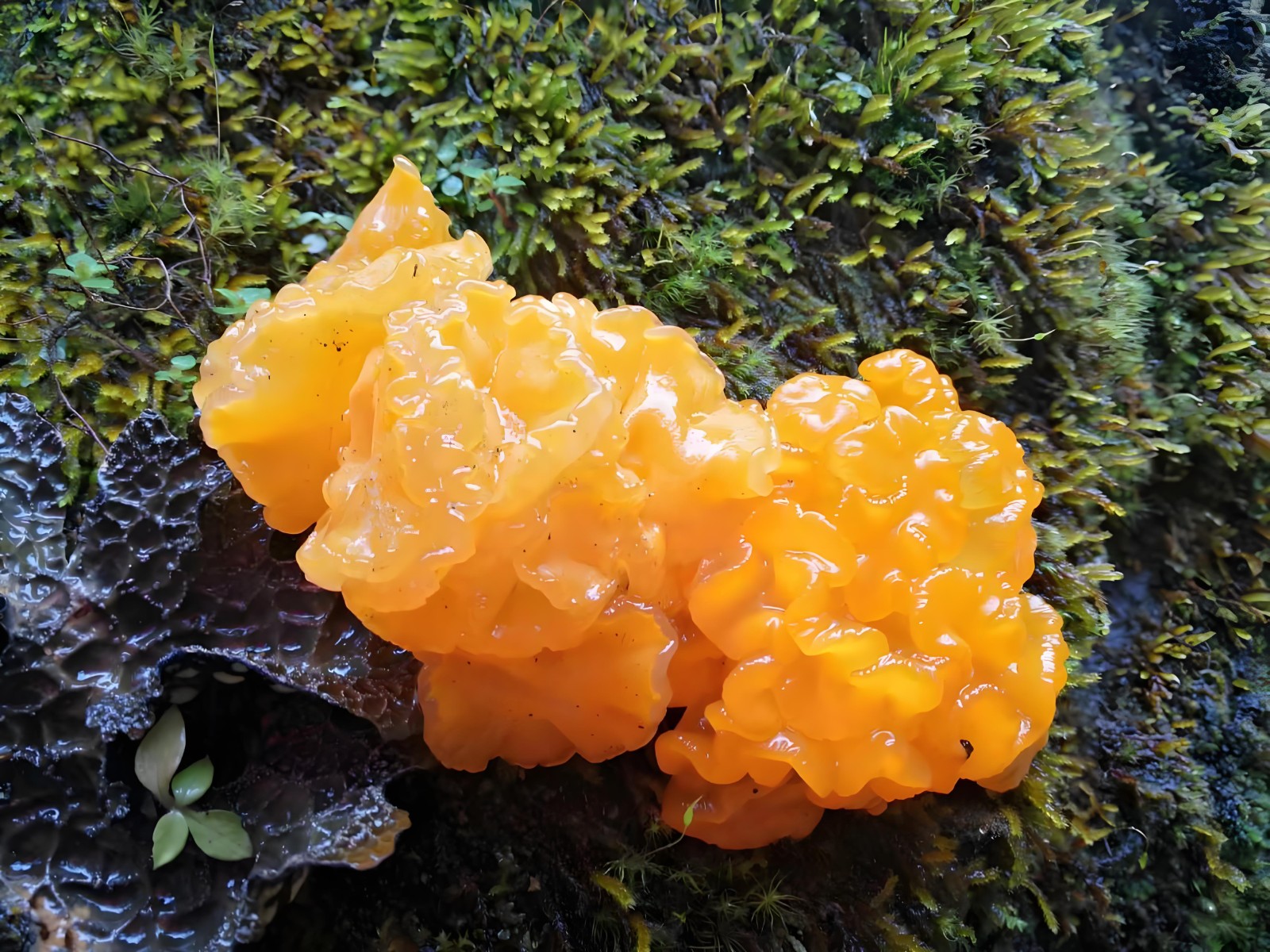
Basic Facts - **Scientific name**: Tremella aurantialba - **Other names**: Brain Fungus, Brain-shaped Tremella, Orange Tremella, Yellow Fungus - **Classification**: Tremellales, Otodendraceae, Genus Tremella - **Ecological distribution**: Primarily Southwest and East China - **Morphological characteristics**: - Brain-shaped or irregularly lobed fruiting body (8ŌĆō15 cm diameter), single or clustered. - Surface: Smooth initially, developing brain-like lobes with maturity; firm, fleshy, turning golden/orange-yellow under good ventilation and moderate light. - Late maturity: Soft internal tissue; white powdery basidiospores in lobed grooves (pale yellow when aggregated). - Cross-section: Golden edges (golden fungus mycelium); white center (hairs of golden fungus and tough leathery fungus *Stereum hirsutum*). - Variations: Color and size depend on cultivation methods.
1. Cultivation History - 1815ŌĆō1822: Mycologist Eles Fries first studied golden fungus, establishing the genus *Naematelia*. - 1983: Huang Nianlai et al. isolated parent species and domesticated cultivation, but fruiting body yield was unstable. - 1982ŌĆō1996: Liu Zhengnan, Zheng Shufang, etc., achieved breakthroughs in log and substitute cultivation (proven suitable for wide application). - Recent years: Yunnan Junshijie Biotechnology developed factory-scale cultivation, expanding cultivation north of the Yangtze River. - Current challenges: Short cultivation history, low public awareness, limited cooking methods, ordinary taste ŌåÆ low market acceptance. - Market status: Fresh golden ear has higher ex-factory price than white ear, but few pre-processed products and inferior taste hinder promotion.
2. Biological Characteristics
- **Nutrition**: - Pure golden fungus mycelium weakly decomposes lignocellulose; relies on companion fungus *Stereum hirsutum* (tough leathery fungus) to break down macromolecules into absorbable nutrients. - *Stereum hirsutum* can complete its life cycle independently; golden fungus cannot (mixed mycelium type). - Similar to white ear (*Tremella fuciformis*), which also needs a companion fungus (ascomycete); both have nearly identical nutritional profiles. - Reproduction: Budding produces yeast-like conidia; germinate into hyphae in slag extract medium (white earŌĆÖs germination is hindered by colloids). - **Temperature**: - Mesophilic; optimal for *Stereum hirsutum* hyphae: 22ŌĆō25┬░C. - Basidiospore budding phase: 18ŌĆō22┬░C. - Low temperatures control *Stereum hirsutum* growth and stimulate golden fungus fruiting body development. - (Note: Golden ear, white ear, and black fungus share the same optimal fruiting body temperature: 18ŌĆō22┬░C.)
- **Light**: - Avoid light during cultivation (mimics natural ecology); e.g., log-inoculated mycelium grows under bark, substitute sticks incubate in darkness until mature. - Strong diffuse light (300ŌĆō500 lux) stimulates formation of pale yellow/orange fruiting bodies.
- **Water**: - Substitute medium moisture: 60%ŌĆō62%. - Fruiting body growth humidity: 90%ŌĆō92% (low humidity slows growth; high humidity risks rot). - Humidity differences promote growth; ground irrigation + internal circulation fans increase humidity.
- **Air**: - Oxygen-intensive; requires constant fresh filtered air. - Poor ventilation at high temperatures impairs ear bud development.
- **pH**: - Thrives in neutral to slightly acidic environments (optimal substrate pH: 6.0ŌĆō6.5). - Spores and *Stereum hirsutum* tolerate a wide pH range; adjust to 6.5ŌĆō7 with gypsum or potassium dihydrogen phosphate in production.
3. Production Model - **Cultivation method**: Dominated by substitute materials (log cultivation is obsolete due to long cycles and low conversion rates). - **Regional timing**: Spring cultivation in northern China; spring and autumn in southern China.
- **Key note on strains**: - Golden fungus hyphae and *Stereum hirsutum* hyphae have a symbiotic (one-sided) nutrient transfer relationship (similar to white ear and its companion fungus *Xylaria*). - Pure golden fungus hyphae grow slowly and cannot form fruiting bodies alone; depend on *Stereum hirsutum* for nutrients. - Unlike wood ear (single hyphae type), golden ear and white ear have mixed hyphae types.








